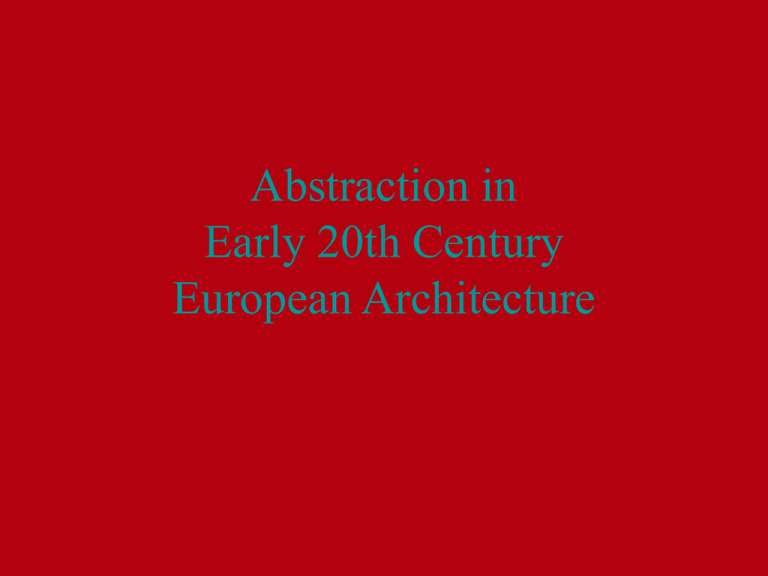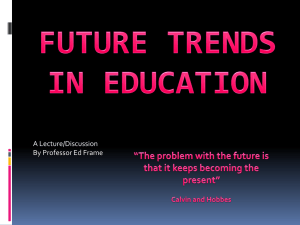AbstractEuroArch
advertisement

Abstraction in Early 20th Century European Architecture L’art nouveau L’art nouveau or “the new art” swept Europe during the last decade of the 19th century, lasting into the 20th century in several locations. Almost every country in Europe had its own term for this movement. The French and the Belgians called it “L’art nouveau,” but the Germans called it “Judgendstil” (style of Jugend) after the magazine of the same name while the Austrians called is “Ze-Ze-Ze” after the “Sezession” (or secession) of artists from the Vienna Academy of Art in protest against the academic atmosphere there. The Italians called it “Liberty” after the store Liberty of London; while the British called it “Arts and Crafts”, a general term for resistance to machine-made objects produced for everyday life. In the majority of its manifestations, art nouveau was an effort to accept new materials such as cast iron by casting them into elegant, curvilinear forms based on vegetation: tendrils, plant stems, buds and flowers, leaves, etc. In some cases, especially in the Germanic countries, geometry played an important role. In all cases, the forms were decorative and often used structure as part of a decorative language that could be applied to flat surfaces as well as to three-dimensional forms. It is possible to argue that art nouveau was both an abstract and a figural style: figural in that it drew on vegetation for much of its ornamental qualities; abstract in its self-justifying curvilinearity that often exceeded the notion of mere representation. Hector Guimard, house and studio, Paris, 1909-10 Charles Rennie Mackintosh, Willow Tea Rooms, Glasgow, Scotland, 1895 Charles Rennie Mackintosh, Glasgow School of Art, 1897-1909 Library wing, c. 1908 Futurism Futurism was founded as a movement by Filippo Marinetti when he published the Futurist Manifesto in 1909. The futurists embraced the machine and industrial technology, calling for an art of “violence, energy, and boldness” while dismissing all traditional art as useless, out of date, and cultural deadweight. The futurists were obsessed with movement and time (and most especially speed). Their notion of modernism was centered on science, new technology, and the destruction of the past in all forms. Umberto Boccioni, a futurist painter and sculptor,wrote his own manifesto, in which he stated: Everything moves, everything runs, everything turns swiftly. The figure in front of us never is still, but ceaselessly appears and disappears. Owing to the Persistence of images on the retina, objects in motion are multiplied and distorted, following one another like waves through space. Thus a galloping horse has not four legs; it has twenty, and their movements are triangular. These sorts of ideas can be perceived in Boccion’s work, such as the painting The City Rises and in his sculptural works. The statue called Unique Forms of Continuity in Space is well known for its attempt to convey motion rather than position only. Umberto Boccioni, The City Rises, c1912 Boccioni, Unique Forms of Continuity in Space, c1913 Although there was no futurist architecture that was an exact counterpart of futurist painting and sculpture, Antonio Sant’ Elia provided a manifesto of futurist architecture to accompany an exhibit of his drawings of the Citta Nuova or “new city” in 1914. It is assumed that Sant’ Elia wrote the manifesto with Marinetti. In it, he called for an architecture that would reinvent the city as a “tumultuous shipyard, active, mobile, and everywhere dynamic.” He envisioned tall buildings without stairways but with elevators that would “swarm up the facades like serpents of glass and iron.” He envisioned no conventional street, but a street that would “plunge storeys deep into the earth, gathering up the traffic of the metropolis, connected for necessary transfers to metal catwalks and high-speed conveyor belts.” Much of Sant’ Elia’s drawings suggest new building types such as power stations, airports, airship hangars, multi-level stations, and stepped apartment buildings. The futuristic qualities of the drawings may have been inspired by 19th-century warehouses and engineering accomplishments as well as by photographs of New York City and its dense architectural massing at the turn of the twentieth century. However, futurist architecture asserted that “’real architecture’ transcends functionalism by being ‘synthesis and expression’; with the suggestion that inspiration be found in ‘the new mechanical world we have created, of which architecture must be the fairest expression, the fullest synthesis, the most effective artistic integration.” Milan Railway Terminal Constructivist Architecture Post-revolutionary Russia was the social and cultural as well as artistic context for contructivist architecture. Eschewing all traditional or inherited forms, constructvists sought to produce an architeture that was the equivalent of the social revolution that was taking place. Vladimir Tatlin’s Monument to the Third International (1919-20), for example, makes use of radical ideas never employed in largescale architecture before: assemblage, suspension, movement, and asymmetrical composition based on a structural double helix. Although never built for a variety of reasons, the form seems to have been inspired by oil derricks, fairground constructions, and futurist images. Yet, it may also be an emblem of Marxist ideology and its principles of historic process of thesis, antithesis and synthesis. Konstantin Melnikov, Rusakov Workers Club, c 1927-28 Ivan Leonidov, Commissaviat, c1927











